Writing technical specifications for software products may not be the most straightforward task out there because it requires you to plan the entire project ahead, put the plan into understandable terms, and update the document regularly.
Despite the effort required, many developers and technical writers still swear by the practice—and for good reasons.
If you’re not sure if investing time and effort in writing technical specifications would be the right move for your product, this article may provide some helpful insights.
We’ll list five reasons why tech specs are a beneficial addition to software development projects.
By the end of the article, you’ll be able to make an informed decision about whether technical specifications can contribute to your product’s success.
To Improve Productivity
Software teams often find themselves struggling with productivity. Luckily, a thorough technical specifications document can provide clarity about the development process and boost productivity as a result.
If you’ve ever worked on a software project that had insufficient documentation, chances are that the environment was chaotic.
Developers asking each other for directions, project managers clinging to already obsolete deadlines—and no resources to turn to for guidance.
In such cases, you can count on the technical specifications to save the project and keep development on track. There are two reasons for that.
Firstly, the solutions laid out in technical specifications resemble the final product so closely that you can use the document as a blueprint.
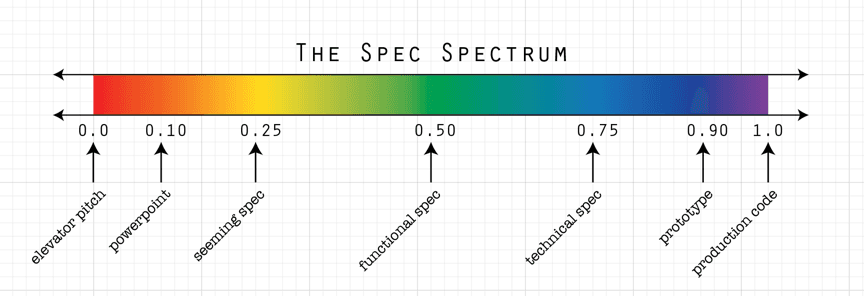
Source: Beeminder
The graph above, designed by Beeminder, shows that if you’ve written your technical specifications properly, 75% of the work on your final project has been done.
In other words, when developers come across a problem, they no longer have to draft solutions from scratch—the answer is already there in the specifications.
This also means that technical specifications aid productivity by removing the need for trial and error. As Daniel Reeves, the founder of Beeminder, puts it:
“The beauty of specs is that you can do most of that backtracking and whittling down and rethinking before you start coding.”
The second reason why writing technical specifications boosts productivity lies in the part of the document that contains the planned timeline and milestones.

Source: Medium
When the team has an overview of the nearing deadlines, they can focus on work that requires immediate attention without wasting time deliberating on what to do next.
So, if you’re aiming to increase productivity in your development team, triple monitors and faster computers may not be the solution.
Instead, creating a comprehensive document that outlines the technical specifications of the product you’re building will grant your team a roadmap they can follow and avoid unproductive distractions.
To Reduce Product Development Costs
Development costs can skyrocket if you don’t have a development plan in place. You can cut costs by designing the technical specifications of the product before you begin coding.
When you set your mind on building a product, it can be tempting to jump straight into development.
Some teams even misinterpret the Agile method and neglect documentation in favor of coding, racking up development costs in the process.
However, taking the time to plan your technical specifications can help you find a structured approach to development that results in better UX, fewer bugs, and lower production costs, as witnessed by developers in this thread about the benefits of tech specs.

Source: Stack Overflow
Essentially, if you start coding without a plan, you’re risking implementing features that are less than ideal for your product.
Removing those features and coming up with better ones requires you to put more hours into programming, so it’s in your best interest to use the tech specs as a development plan to save you from redevelopment.
Moreover, it’s next to impossible to write code with no bugs whatsoever. But the sooner you catch them, the less they damage your budget.
An IBM System Science Institute study has shown that code defects found during testing are fifteen times more costly than if they were found in the early design phase.
The cost gets even more severe if a bug creeps into the production stage unnoticed.

Source: Archbee.com
So, if you detected a defect while writing technical specifications, you could lose, say, $100.
However, that figure pales in comparison with the $10,000 you’d have to fork out if the defect remained there until the release.
All in all, writing technical specifications forces you to examine your product down to the smallest details.
Such an exhaustive approach will allow you to identify possible architectural issues and eliminate them before they get the chance to snowball into pricier problems.
To Enable Team Scalability
If your team needs to scale, that’s a good sign! Technical specifications are such a versatile tool that they can also help you with scalability by facilitating knowledge sharing.
You’ve recognized the need to scale, recruited new developers, and now it’s time to onboard them.
At this stage, a lack of product documentation can cause your new hires to waste more than a quarter of their time on asking colleagues for help, according to Panopto research.

Source: Archbee.com
However, a document describing the technical specifications of the product a new hire has been assigned to can help them understand the project quicker.
Whether you introduce one or ten new hires to the team, they can use the tech specs as a self-learning tool to get on board with the project independently.
Here are two read recommendation related to software documentation tools:
1. 7 Common Features All Good Software Documentation Tools Have
2. Benefits of Software Documentation Tools
Reduced onboarding costs are just an added benefit of this approach.
It’s best to keep this educational function of the document in mind while you’re still writing it.
Rather than assuming prior knowledge, a good tech specs document describes the product from the ground up, so that people who join the team can understand it regardless of their seniority.
In other words, you should consider all team members who participate in the development as your target audience. This may also include non-technical roles, such as project managers.
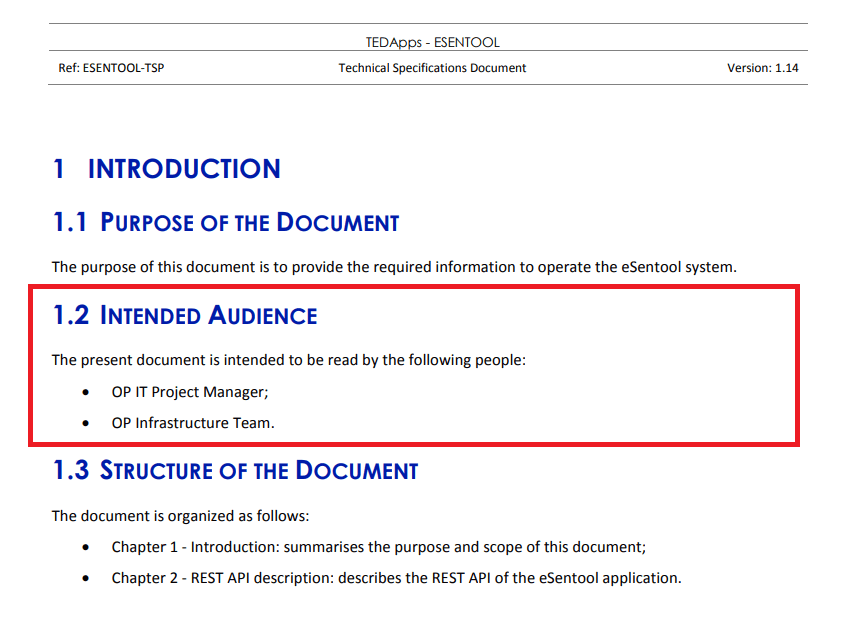
Source: TED eSentool
Even developers themselves prefer getting acquainted with projects through documentation.
While materials describing the coding processes in your company may become outdated, properly maintained software docs reflect the accurate state of the product, which makes them an excellent resource for newly joined developers to learn about the project.
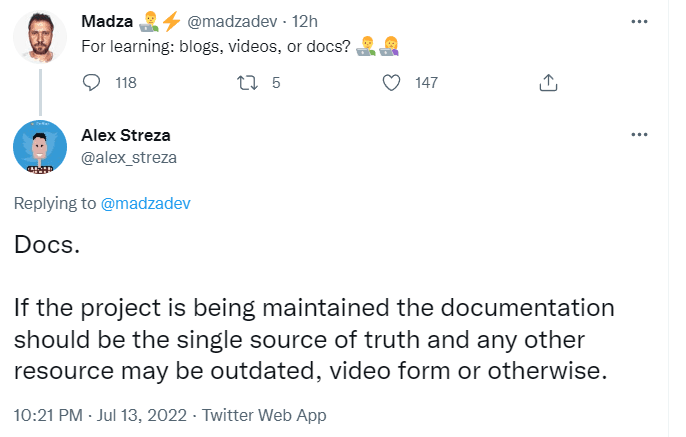
Source: Twitter
All in all, if you want to scale your team painlessly, you have to consider how the new additions to the team will get up to speed.
You can use software documentation to your advantage—if you’re already building it for development purposes, why not also use it to expedite scaling.
And since technical specifications contain an abundance of relevant information about the product structure and the development process, they are an immensely valuable instrument here.
To Reduce Risks and Failure
While technical specifications usually don’t contain sections on risk mitigation, they can still help you reduce financial, functional, and legal liabilities.
Joel Spolsky, founder of Trello, advocates writing a technical specifications document for every software project that’s expected to take more than a week to develop.
In fact, he considers not writing the specifications “the single biggest unnecessary risk” in software projects.
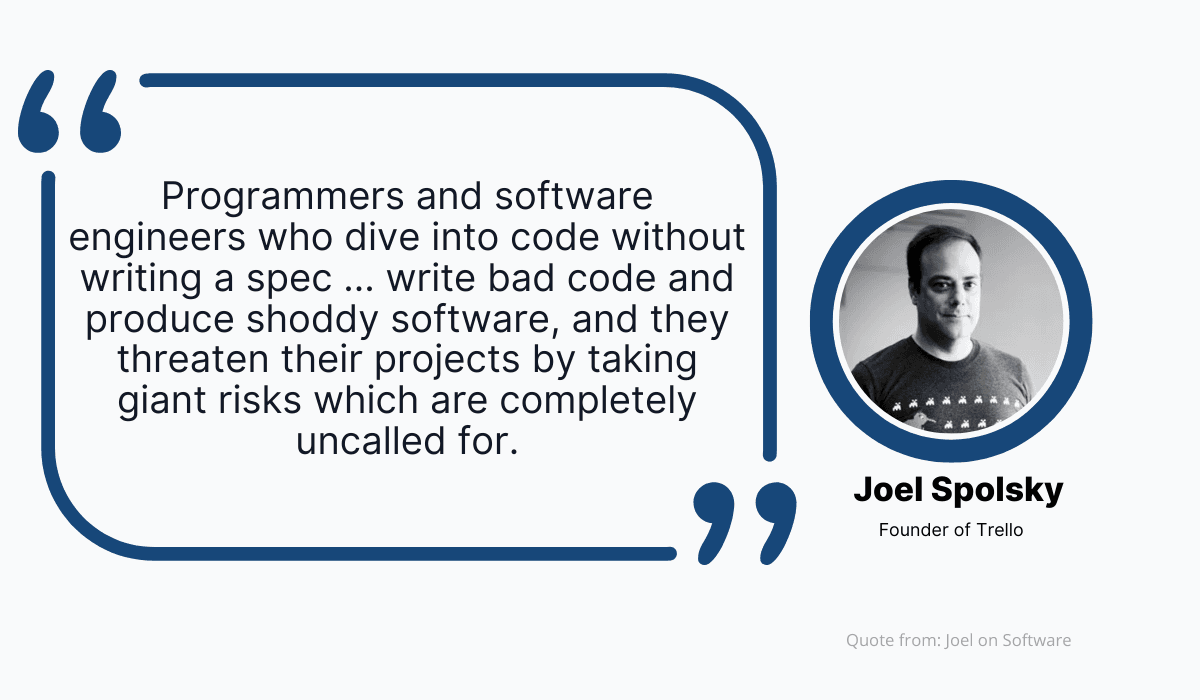
Source: Archbee.com
Essentially, coding without following technical specifications forces developers to make rash decisions, endangering both your budget and the functionality of your product.
But if you analyze the product’s architecture while writing technical specifications, you’ll have an opportunity to spot potential issues and resolve them before they occur.
Tech specs can also protect you from legal risks because they force you to scrutinize privacy and security issues.
So, coming up with security solutions before the development process begins lets you approach the matter with enough time to consider all edge cases and devise the safest solution possible.
That way, you’ll avoid putting the end-user’s data in jeopardy and prevent possible lawsuits down the line.
To Create Better Products
What do you get when you merge improved productivity, reduced risks and costs, and the possibility of scaling the development team?
That’s correct—writing technical specifications helps you create better software in general.
Quick read recommendation: 7 Tips That Show You How To Improve Software Documentation
Let’s take a look at the situation the other way around.
Did you know that 47% of business projects fail due to inaccurate requirements management?
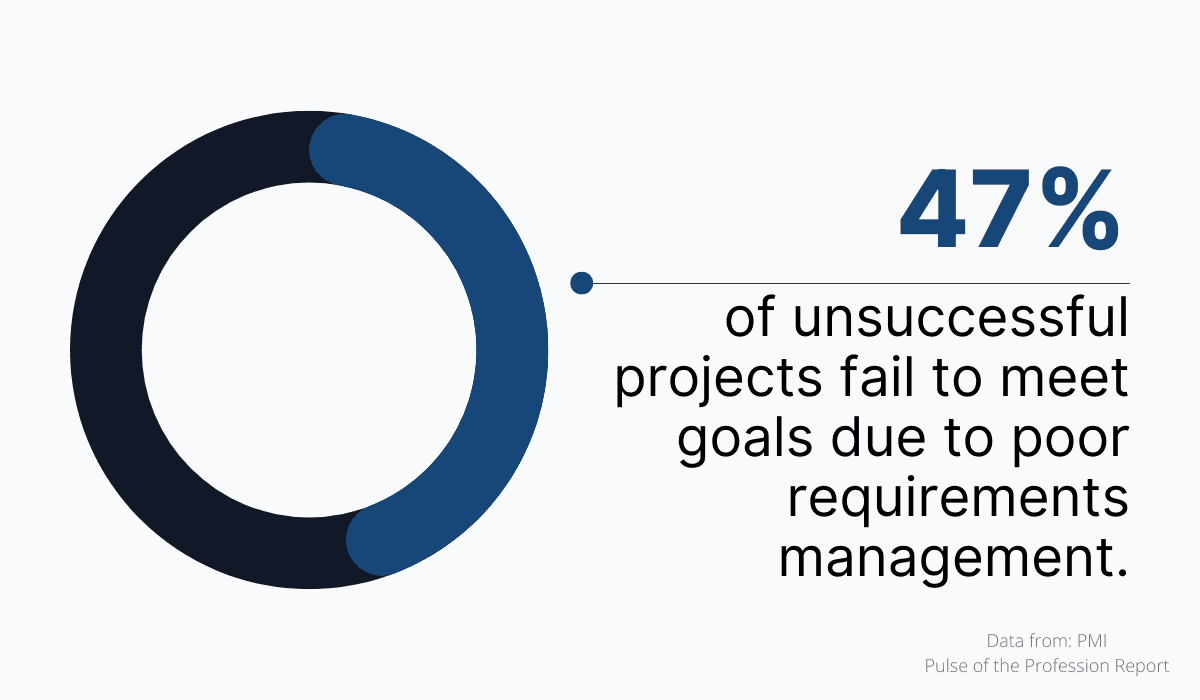
Source: Archbee.com
While this piece of information from the PMI report may sound disheartening, it also tells us that business failures are preventable half of the time.
Taking the time to design all-encompassing technical specifications lets you review your product as a whole, including its requirements.
You can then find the most suitable way to develop the product.
Moreover, writing the technical specifications will allow you to identify the weaknesses and build a better product than you’ve initially envisioned.
Admittedly, writing tech specs takes time and resources. Still, considering that this preparatory step results in better products, it’s a reasonable investment.
Conclusion
The benefits of coding by using technical specifications as scaffolding go beyond the ease of development.
Writing this type of software document also has quantitative benefits: it helps you save money by improving productivity and preventing costly bugs and mistakes.
So, although writing technical specifications may postpone the start of development by a few weeks, the advantages of doing so certainly justify the investment. Hope now you know why you should write technical specifications for your product!
Try Archbee's full range of features with our free 14-day trial.
FAQ
Frequently Asked Questions
Because specs turn ideas into an executable plan and de‑risk delivery.
- Create a concrete blueprint (architecture, data flows, API contracts) so developers aren’t guessing.
- Clarify scope and success with testable requirements, acceptance criteria, and a decision log.
- Expose risks and edge cases early, when they’re fastest and cheapest to address.
- Improve planning with better estimates, milestones, and dependencies for realistic scope and timelines.
- Accelerate onboarding and knowledge sharing as the team grows.
- Bake in security, privacy, and compliance from day one.
Think of the spec as a living guide that complements Agile: you iterate the document as you learn, enabling faster, better‑coordinated delivery.
